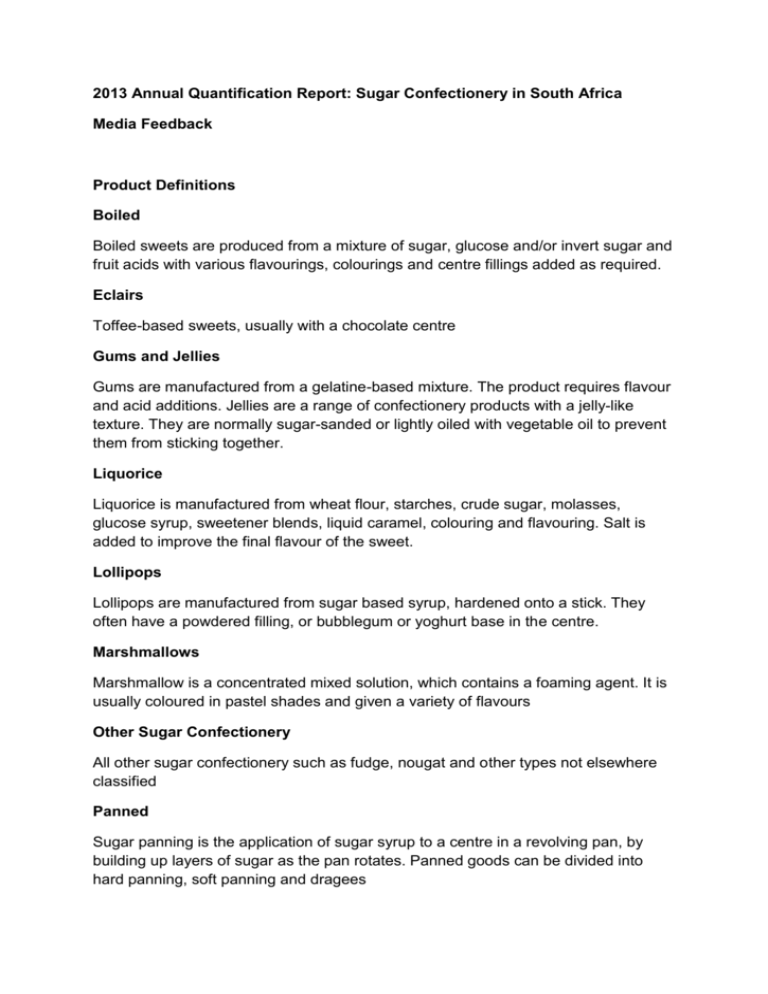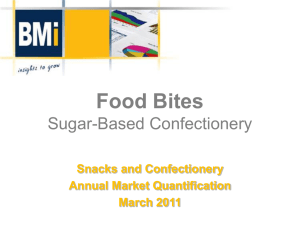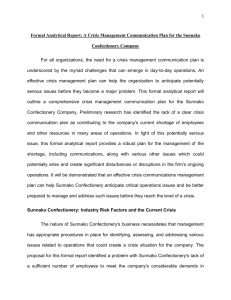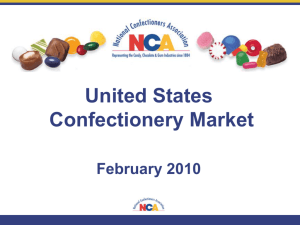2013 Annual Quantification Report: Sugar Confectionery in South
advertisement

2013 Annual Quantification Report: Sugar Confectionery in South Africa Media Feedback Product Definitions Boiled Boiled sweets are produced from a mixture of sugar, glucose and/or invert sugar and fruit acids with various flavourings, colourings and centre fillings added as required. Eclairs Toffee-based sweets, usually with a chocolate centre Gums and Jellies Gums are manufactured from a gelatine-based mixture. The product requires flavour and acid additions. Jellies are a range of confectionery products with a jelly-like texture. They are normally sugar-sanded or lightly oiled with vegetable oil to prevent them from sticking together. Liquorice Liquorice is manufactured from wheat flour, starches, crude sugar, molasses, glucose syrup, sweetener blends, liquid caramel, colouring and flavouring. Salt is added to improve the final flavour of the sweet. Lollipops Lollipops are manufactured from sugar based syrup, hardened onto a stick. They often have a powdered filling, or bubblegum or yoghurt base in the centre. Marshmallows Marshmallow is a concentrated mixed solution, which contains a foaming agent. It is usually coloured in pastel shades and given a variety of flavours Other Sugar Confectionery All other sugar confectionery such as fudge, nougat and other types not elsewhere classified Panned Sugar panning is the application of sugar syrup to a centre in a revolving pan, by building up layers of sugar as the pan rotates. Panned goods can be divided into hard panning, soft panning and dragees Toffees, Caramels and Chews Toffees and chews are a high boiled mixture of sugar, fat, milk and glucose syrup with the addition of salt and other flavours poured onto a slab and marked into shapes. Caramels are a high boiled mixture of sugar, fat, milk and glucose syrup with the addition of salt and other flavours that forms a more viscous mass needing to be rolled out and cut into small pieces whilst still warm. Market Trends The boiled sweets market, which has been declining for the past two years, saw its greatest drop in volumes during 2012. This decline was caused primarily by major players who are either no longer focusing on the product, or have close on stopped their production of this category. Category pricing saw a significant increase during the base year, this being the largest growth rate since 2008. However, even with the price increase, the drop in volume was too large to sustain the overall value for the category. Boiled sweets saw a large drop in distribution into the foodservices sector. It is believed that the driver for this is the increase in usage of chewing gum as an after meal breath freshener. Retail however saw growth this year, as distribution was focused into this channel. Distribution into the Northern Cape was the only provincial growth in 2012, however the volumes moving into this region were still low compared to that of the more populated regions. Eclairs saw growth during the base year, continuing on from the increase in 2011 for 2012. This growth is expected to slow down in the coming years, as the market has established itself well and high growth rates may not be sustainable. Given the pressures faced by the confectionery industry as a whole, a more conservative volume outlook is envisaged. All channels of distribution for eclairs saw growth in 2012, with independent wholesalers receiving the largest focus. The Free State saw a decline in regional distribution, the only decrease seen in 2012. The gums and jellies market, which covers products such as jelly tots, gum drops, wine gums and jelly babies, has seen a large push in production from companies in 2012. This comes as many other products in this market saw declining volumes in the base year. The average per kilogram pricing for this category increased for 2012, although at a reduced rate compared to the previous year. Gums and jellies are distributed mainly through general retail and, to a lesser extent, via the wholesale sectors. This increased this year, as the remaining sectors felt less focus from distributors and manufacturers. Liquorice saw a decrease in volumes for 2012, as prices were pushed up last year, with some producers stating they felt this caused consumers to slow their purchasing of this product. The base year pricing saw an increase but by far less than previously, as producers try to grow demand within the market. Lollipops saw a decrease in volumes during 2012. This may be primarily due to product shifts as players move into new markets, such as bubble gums. Some players were of the opinion that the market is dominated by several larger players, which makes for a very pressured, competitive market situation. Marshmallows recovered lost ground during 2012 as the market regained volumes after a decline in 2011. The value for this market grew from 2011, aided by price increases given by manufacturers. The more densely populated regions such as Gauteng, KwaZulu-Natal and the Western Cape continued to experience good growth in their gums and jellies distribution, but this did not affect the smaller provinces, which saw good growths as well due to the size of the growth in the total market. Marshmallows channelled into general retail lost share to the wholesale sector, where both independents and chains saw large increases in distribution. KwaZulu-Natal and Limpopo lost share to the large Gauteng, whilst the remainder of the market was flat moving into 2012. Other sugar confectionery saw growth during the base year, and the category is expected to continue increasing in 2013. A relatively static market state is anticipated for 2014. This category includes popular, premium-type nougat and honeycomb type products, which gain popularity as gifts during the festive seasons. This has helped to maintain the popularity of this category. The regional distribution for this category maintains good representivity throughout the country, though Gauteng holds a substantial share of the market Panned confectionery is one of the smaller confectionery markets in volume terms, with only a few players contributing to the category production. The value for the market saw substantial growth as increases in both the pricing and volumes underpinned the overall market value. The wholesale and retail sectors dominate the distribution of panned confectionery, though garage forecourts is beginning to take a greater share of the market as well, as some players began focusing on this sector during the base year. The larger provinces hold the larger share of the regional distribution of the category. The 2012 year saw erosion in share for KwaZulu-Natal, Limpopo and Northern Cape. Toffees, caramels and chews saw a small decrease in production in 2013. This is relatively positive considering the substantial declines seen for alternative competing confectionery categories. The value for this market increased, though not as high as in previous years. This is due in part to the lower pricing increase felt in 2013.











